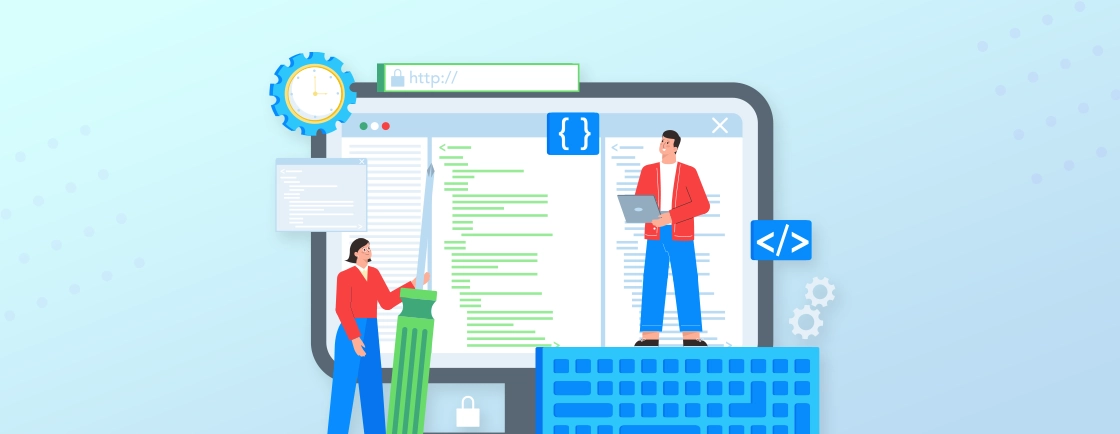Table of Contents
Online learning has become a key part of education and professional development. With more people seeking flexible, accessible ways to learn, creating your own online learning platform can be a great opportunity.
But building such a platform can feel overwhelming. From choosing the right tools to designing an engaging user experience, there are many decisions to make.
The good news is that with the right approach and tools, you can build LMS from scratch that meets the needs of both instructors and learners.
In this blog, we are going to discuss everything you need to know to build your own online learning platform. For a simplified process, working with an experienced LMS development company can make a huge difference in creating a smooth and scalable solution.
Online Learning Platform Overview
An online learning platform is a digital space where instructors can deliver educational content to students through courses, videos, quizzes, and other resources. These platforms allow learners to study at their own pace, from anywhere, and on any device. They are often used by schools, universities, businesses, and independent educators to provide structured learning experiences.
Types of Online Learning Platforms
- Course-Based Platforms: These platforms offer structured courses with lessons, assignments, and assessments. Examples include platforms like Udemy or Coursera.
- Subscription-Based Platforms: Users pay a recurring fee for access to a wide range of courses. Examples include LinkedIn Learning or Skillshare.
- Learning Management Systems (LMS): These are more customizable platforms often used by businesses and educational institutions to manage content, track progress, and communicate with learners.
- Microlearning Platforms: These platforms focus on short, bite-sized lessons that can be completed in a short time. Examples include platforms like Duolingo or Blinkist.
Why Create Your Own Online Learning Platform?
Creating your own online learning platform offers several advantages:
- Control Over Content: You can tailor the content to your specific audience and teaching style.
- Branding: Having your own platform allows you to create a unique learning experience that reflects your brand.
- Revenue Generation: You have the flexibility to set pricing, offer subscription models, or charge for individual courses.
- Customization: You can choose the features and tools that best suit your needs, whether it’s gamification, interactive lessons, or community forums.
- Scalability: As your platform grows, you can easily add new courses, features, and users without being limited by third-party platforms.
Building your own online learning platform provides the flexibility and control to create a tailored, sustainable educational environment.
Steps to Build an Online Learning Platform
We have divided the process of building an online learning platform into six easy steps:
Step 1: Planning & Strategy
Before getting started with the development process, it’s important to set a clear strategy.
Define Your Purpose & Goals
What do you want to achieve? Whether it’s upskilling employees, generating revenue, or providing educational resources, clear goals will guide your decisions.
Identify Your Target Audience
Who are you building this platform for? Consider their demographics, learning styles, goals, and pain points to tailor the experience.
Conduct Market Research
Analyze your competition, identify their strengths and weaknesses, and spot trends in online learning. Understand the demand for your platform.
Choose a Business Model
How will you generate revenue? Options include subscription fees, pay-per-course, freemium models, or corporate training partnerships. Consider scalability and profitability.
Develop a Budget & Timeline
Estimate costs for technology, content, marketing, and maintenance. Set a realistic timeline with milestones to keep development on track.
By addressing these strategic factors, you can create a solid foundation for a successful online learning platform.
Step 2: Choose the Right Technology
The technology you choose affects the user experience and success of your online learning platform. Here are key considerations.
Learning Management Systems (LMS)
An LMS helps deliver, track, and manage learning activities.
Key Features:
- Course Creation: Drag-and-drop tools, video hosting, quizzes.
- User Management: Enrollment, progress tracking, certifications.
- Communication: Forums, messaging, live chat.
- Analytics: Track learner progress and areas for improvement.
- Integrations: Sync with video tools, payment gateways, CRMs.
Content Creation Tools
Create engaging learning materials using these tools:
Video:
- Camtasia: Easy screen recording and editing.
- Adobe Premiere Pro: Professional video editing.
- OBS Studio: Free for recording and live streaming.
Interactive Content:
- Quizlet: Flashcards and quizzes.
- Articulate Storyline: Interactive eLearning courses.
Design:
- Canva: Simple design for presentations and graphics.
- Adobe Creative Suite: Advanced design tools.
Website & Hosting
Choose a platform and hosting provider that supports learning needs.
Website Builders:
- WordPress: Customizable with many plugins.
- Wix: Easy drag-and-drop design.
- Squarespace: Elegant templates.
Hosting Providers:
- Bluehost: Reliable with great support.
- SiteGround: Fast performance.
- Cloudways: Managed cloud hosting for high traffic.
Choosing the right technology will help you build a functional and engaging online learning platform, whether you opt for a Cloud vs Self-Hosted LMS approach.
Step 3: Create High-Quality Content
High-quality content is key to the success of your online learning platform. It keeps learners engaged, improves retention, and drives results.
Course Design Principles
- Know Your Audience: Tailor content to learners’ needs and styles.
- Simplify Complex Topics: Break them into smaller sections with clear language, visuals, and videos.
- Incorporate Interactivity: Use quizzes, discussions, case studies, and gamification to engage learners.
- Provide Regular Feedback: Offer constructive feedback and track progress with analytics.
Content Formats
- Videos: Lectures, interviews, and demos with good audio and video quality.
- Text: Articles, ebooks, and resources with clear, concise language and formatting.
- Audio: Podcasts, audiobooks, or lecture recordings.
- Interactive: Quizzes, games, and simulations.
Invest in professional editing and clear presentation to boost engagement and learning experience. By focusing on creating engaging, high-quality content, you can build a successful online learning platform that delivers value.
Step 4: Focus on Marketing & Growth
Attracting and retaining learners is key to your platform’s success. Here are effective marketing strategies.
Content Marketing
- Create valuable content: blogs, articles, case studies, and webinars.
- Optimize for SEO: Use relevant keywords, improve titles, and build backlinks.
- Share on social media: Post your content and engage with followers.
Social Media Marketing
- Build a presence on platforms like LinkedIn, Facebook, and Instagram.
- Share engaging content: videos, infographics, and behind-the-scenes posts.
- Run contests and use targeted ads to reach potential learners.
- Partner with influencers to expand reach.
Email Marketing
- Build an email list by offering free content.
- Send targeted campaigns: welcome emails, promotions, and updates.
- Personalize emails to match each subscriber’s needs.
Paid Advertising
- Run ads on Google and social media platforms.
- Use pay-per-click (PPC) to drive traffic and track ad performance.
Community Building
- Create online forums and host webinars or live Q&As.
- Encourage learner feedback and testimonials to build trust.
By implementing these strategies, you can attract and retain learners, growing your platform successfully.
Step 5: Monetization Strategies
Monetizing your platform is key to its sustainability. Here are several revenue models to consider.
Subscription Model
- Charge a recurring fee for access to courses, with tiered plans for different budgets.
- Offer exclusive benefits like early access or discounts.
- Example: Netflix, MasterClass
Pay-Per-Course Model
- Charge a one-time fee for individual courses or bundles.
- Example: Udemy, Coursera
Freemium Model
- Offer limited free content to attract users, then upsell premium courses or subscriptions.
- Example: Duolingo
Corporate Training
- Partner with businesses for tailored employee training programs.
- Example: LinkedIn Learning, Pluralsight
Affiliate Marketing
- Promote third-party products and earn commissions on sales.
- Example: Amazon Associates
Bundles and Packages
- Offer course bundles or special packages at a discount to increase sales.
Live Workshops and Coaching
- Charge for live workshops or one-on-one coaching with expert instructors.
Membership Sites
- Create exclusive communities offering special content, Q&A, and networking.
Choosing the Right Model
- Consider your audience and business goals, then test different models to see what works best. Regularly analyze and adjust your approach.
With the right strategies, you can ensure the profitability and growth of your platform.
Step 6: Check Legal Compliance
Ensure your online learning platform is legally compliant to protect your business and learners.
Terms of Service & Privacy Policy
- Create clear Terms of Service and Privacy Policy outlining rules, data usage, and intellectual property.
- Obtain user consent for personal data collection and ensure transparency.
Intellectual Property Rights
- Respect copyright laws and ensure content is licensed or in the public domain.
- Educate learners on responsible use of copyrighted material.
Data Privacy & Security
- Implement strong data security to protect user information.
- Comply with regulations like GDPR and CCPA, and keep security measures updated.
Accessibility
- Ensure your platform is accessible to all users, including those with disabilities.
- Follow WCAG guidelines for screen readers and keyboard navigation.
Consumer Protection Laws
- Follow regulations on advertising, sales, and refunds.
- Provide accurate course details, pricing, and refund policies.
Legal Updates
- Stay informed on legal changes and regularly update your policies.
- Consult with legal experts to ensure full compliance.
By addressing these legal factors, you can build a trustworthy and compliant learning platform.
Must-Have Features for Online Learning Platform
To create an effective online learning platform, ensure it includes these key features:
- User-friendly interface: Easy navigation for learners and instructors.
- Course creation tools: Support for video, text, quizzes, and interactive content.
- Progress tracking: Let learners track their progress and set goals.
- Communication tools: Include forums, chat, or video conferencing for engagement.
- Payment gateways: Secure payment options for course purchases.
- Mobile compatibility: Ensure the platform is accessible on mobile devices.
- Gamification: Use badges, rewards, or leaderboards to motivate learners.
These features will enhance the learning experience and help retain users.
Cost and Budgeting for Online Learning Platform
Building an online learning platform involves several costs. Consider these key areas when budgeting:
- Development costs: Includes platform design, features, and software licensing.
- Content creation: Budget for video production, course materials, and instructor fees.
- Marketing: Allocate funds for advertising, content marketing, and SEO.
- Hosting & Maintenance: Ongoing costs for hosting services and technical support.
- Legal & Compliance: Include costs for terms of service, privacy policy, and compliance measures.
Plan your budget carefully to ensure long-term success and scalability.
Sectors in Which Online Learning Platform is Useful
Online learning platforms are valuable in several sectors, including:
- Education: Schools, colleges, and universities offering courses online.
- Corporate Training: Companies upskilling employees with training programs.
- Healthcare: Medical professionals learning new techniques or certifications.
- Technology: Developers and IT professionals upskilling on the latest tools.
- Personal Development: Individuals learning new hobbies or skills, like photography or cooking.
The flexibility of online platforms makes them ideal for diverse industries and learning needs.
Potential Challenges
While building an online learning platform, you may face these challenges:
- Content creation: Developing engaging, high-quality content takes time and effort.
- User engagement: Keeping learners motivated and active can be tough.
- Technical issues: Platform bugs, slow load times, or integration problems can frustrate users.
- Monetization: Choosing the right revenue model and balancing free vs. paid content can be tricky.
- Legal compliance: Ensuring the platform meets all privacy and accessibility regulations.
Understanding these challenges will help you address them early in your planning process.
Conclusion
Building a successful online learning platform requires careful planning, strategic execution, and a commitment to continuous improvement. Start by defining your goals, understanding your target audience and choosing the right technology.
Create high-quality content, and implement effective marketing & monetization strategies. This will help you to establish a thriving online learning platform that delivers value to learners and achieves your business objectives.
Remember to prioritize user experience, maintain high-quality standards, and adapt to the evolving needs of your learners. With dedication and a focus on continuous improvement, you can build a lasting and impactful online learning platform. For expert assistance, contact the leading LMS development company toay.
FAQs on Online Learning Platform Development
How do I choose the right platform for building my online learning site?
Consider your budget, technical skills, scalability, and specific learning needs. Popular options include WordPress, Wix, and Squarespace for ease of use, while custom-built solutions offer more flexibility.
How can I keep learners engaged on my platform?
Incorporate interactive elements like quizzes, discussion forums, gamification, and live sessions to keep learners involved and motivated.
Can I integrate third-party tools with my online learning platform?
Yes, most platforms allow integrations with tools like video conferencing software, payment systems, and marketing platforms to enhance functionality.
Explore Our Expert Guides
Dive into detailed tutorials, tips, and strategies designed to help you grow, innovate, and solve problems efficiently.





